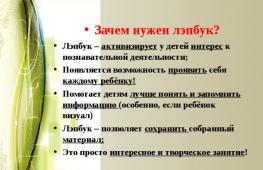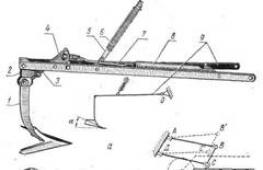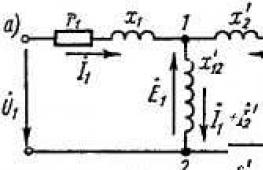What can be made from tetra pack juice. Master class: Vase made of tetrapacks
You can make something useful and beautiful out of almost any seemingly unnecessary thing. For example, empty milk cartons... Shall we make a vase out of them?
Materials:
- Empty boxes of milk, juice, etc. - tetrapacks
- Ruler
- Pencil
- Scissors
- Sandpaper
- Paper tape
- Primer
- Newspapers
- PVA glue
- Putty
- Roller
- Dye
- Brush
- Cord, buttons for decoration
- Glue gun
We will need at least 5 tetrapacks. I have liter boxes - you can take larger ones - then the vase will be larger. The number of boxes depends on the number of desired sides of the vase plus one more tetrapak on the bottom. I will make the simplest option - from 4 faces. Although it is not much more difficult to make a vase with a large number of edges.
Bend down the corners of the package
Let's straighten it out
Cut off the top and bottom along the fold line already on the bag
The result is a semi-finished product
cut along the gluing line of the package - it is on the back side of the box
We get this sheet with ready-made folds
Mark and cut out the workpiece. The shape of the future vase can be varied as desired
Using the first blank, we cut out three more.
That's a total of four pieces. These are the walls of the future vase. Lightly sand them with sandpaper.
We fold the two blanks with the shiny sides facing each other and glue them together with paper tape.
We put a third one inside the two glued blanks and also tape the junction of the second and third blanks with tape.
Tape the fourth rib
and connect the first and fourth blanks also using tape.
Already something similar to a vase
Cut out a square for the bottom. The width of the workpiece at the bottom is 9 cm. This means we need a square with sides of 9 cm.
Glue with tape
We prime our future vase with any universal construction primer.
For gluing workpieces, it is better to use special packaging paper tape - it holds very well and does not come off. Then you don’t have to cover the vase with newspapers. I only had construction tape - it was not originally intended for long-term gluing, so I played it safe and covered the vase with PVA newspapers. If you have good tape, just glue it additionally to the edges of the vase.
Prime the surface again
I paint with white acrylic paint
For decoration we use a mixture of putty and PVA. I have not just putty, but mastic for laying tiles - it is very thick. That's why I'm on the 1st tbsp. I took a spoonful of mastic 1 tbsp. spoon of PVA. For regular putty, you can add 1 tsp to 1 tablespoon of putty. PVA.
Stir our mixture.
Apply to the vase using a spatula
And using a roller we form a pattern on the surface
It turns out this is the texture. By changing the direction of movement of the roller, you can achieve different patterns. You can use other objects to create texture - for example, a large-pored sponge, crumpled cellophane, special rollers with a pattern. You can apply the putty using a stencil, creating relief patterns, or squeeze it out of a hair dye jar and draw any pattern.
Let's paint our vase. Any painting method can be used. You can simply tint the surface of the vase. To do this, dip the brush lightly into the paint, smear the excess paint on some unnecessary piece of paper and, using an almost dry brush, carefully, barely touching the surface, apply paint to the raised areas.
If you don’t want to have a white background, you can paint the entire vase before tinting. I painted the bottom black, the middle gray, and the top light gray.
And I tinted the top with a “dry brush” of white paint. This is the texture we got
We decorate the neck of the vase using a cord. It is best to attach it with a glue gun
We decorate the glued cord with decorative buttons (beads, flowers, etc.)
Now you can put flowers
But the vase is already in the interior for which it was made (the main colors of the interior: white, gray and black. Color accents - green)
Tetra pack boxNo, just look: everything, everything that people are ready to recognize as unnecessary and throw away, skillful hands use to make something useful! For example, a box.
The organizer box is really good.
This box is made from ordinary milk tetra packs and a small amount of additional materials. And inside there are also partitions - it’s convenient storage
For production we will need:
2 tetra packs of milk,
Thick cardboard (I have a box of sweets and “Malyutka” milk formula),
Thick cardboard (box from household or computer equipment)
Kraft paper,
Two small magnets or magnetic clasp
Two types of braid + knitted cord from Iris threads,
Beautiful paper for decoration (I have a wallpaper border for a tapestry, leftovers from renovation),
Beads + 1 pc. marbles (for the clasp, we will trim the cabochon),
4 wooden beads for legs,
Scissors and PVA glue.
These are our tetrapacks
We take craft paper and cut it into strips 9-10 cm wide and 34-35 cm long. Then we crush it thoroughly (the main thing is not to overdo it, so as not to tear it). We straighten the crumpled paper.
Now we paste these strips over the inside of our six boxes and glue the pasted blanks together. I'm sorry, but I don't have this photo. The kids were distracted and I forgot to take a photo.
Then we cut out the bottom for our box from thick cardboard and also cover it with crumpled kraft paper.
After this, we also cut out the sides for our box from thick cardboard, 2 pieces. (6.5 cm by 14.3 cm) they are slightly higher than the glued tetra packs. And 2 pcs. (6.5 cm by 21.3 cm). Next, we connect the pasted bottom and sides using masking tape. We get this box.
Now we take a wallpaper border and glue the outside of our box (only the sides) 1.5 centimeters and bend the border inward. We insert our tetra packs into the glued box and glue them to the box.
Further steps - make a lid for the box.
We cut out three blanks from thick cardboard.
We also cover them with crumpled craft paper and place them under a press until they dry completely so that the lid does not deform.
While the lid is drying, make the fastener.
First, let's trim our marbles with beads. If there is a natural stone it will be even more beautiful).
We cut out a blank for the fastener from thick cardboard (length 4.5 cm, width 2 cm). We also cover it with craft paper.
Now let's assemble our clasp.
To realize my idea, I collected tetra packages of milk, juice, etc. for a long time. The foil base of the packaging gives the product elasticity and high-tech appeal. See below how I made a lamp from Tetra Pak packaging.
Materials and tools:
-Tetra Pak packaging;
-ruler;
-stationery knife;
- silicone glue;
- hot glue gun;
-depending on whether you want a pendant lamp or in the form of a floor lamp, you will need metal rods or any chains on which the lamp will hang (this will be my next work).
-light bulb socket, light bulb (housekeeper), any wire, toggle switch.
Progress of work on making a lamp with your own hands
I thoroughly washed the packaging, leveled it and dried it. When there was a bunch, I started cutting 2 sizes, 13 cm x 1.8 cm and 13 cm x 2.1 cm.
Next, fold the cut strips (13x2.1) into the shape of small triangles, and glue 6 pieces together, so that 6 corners are in the center. According to this principle, glue together more of these elements from 6 triangles. After that, you need to fold it in a circle and to a height of 25 cm or more. When folding and gluing, it would be good to help yourself with fasteners with needles until the glue dries completely. Using stripes of different sizes, and therefore triangles, I give the lampshade a conical shape.
What can I say? ... It's a labor-intensive process, but the result is worth it, you really can't buy a lamp like this in any store. And how much does it cost? ... A little free time (a little more :)), and not least patience and understanding that such a beautiful lamp is made from garbage, thereby cleaning up the environment.



You can make something useful and beautiful out of almost any seemingly unnecessary thing. For example, empty milk cartons... Shall we make a vase out of them?
Materials:
- Empty boxes of milk, juice, etc. - tetrapacks
- Ruler
- Pencil
- Scissors
- Sandpaper
- Paper tape
- Primer
- Newspapers
- PVA glue
- Putty
- Roller
- Dye
- Brush
- Cord, buttons for decoration
- Glue gun
We will need at least 5 tetrapacks. I have liter boxes - you can take larger ones - then the vase will be larger. The number of boxes depends on the number of desired sides of the vase plus one more tetrapak on the bottom. I will make the simplest option - from 4 faces. Although it is not much more difficult to make a vase with a large number of edges.
Bend down the corners of the package

Let's straighten it out

Cut off the top and bottom along the fold line already on the bag

The result is a semi-finished product

cut along the gluing line of the package - it is on the back side of the box

We get this sheet with ready-made folds

Mark and cut out the workpiece. The shape of the future vase can be varied as desired

Using the first blank, we cut out three more.

That's a total of four pieces. These are the walls of the future vase. Lightly sand them with sandpaper.

We fold the two blanks with the shiny sides facing each other and glue them together with paper tape.


We put a third one inside the two glued blanks and also tape the junction of the second and third blanks with tape.


Tape the fourth rib

and connect the first and fourth blanks also using tape.

Already something similar to a vase

Cut out a square for the bottom. The width of the workpiece at the bottom is 9 cm. This means we need a square with sides of 9 cm.
Glue with tape



We prime our future vase with any universal construction primer.

For gluing workpieces, it is better to use special packaging paper tape - it holds very well and does not come off. Then you don’t have to cover the vase with newspapers. I only had construction tape - it was not originally intended for long-term gluing, so I played it safe and covered the vase with PVA newspapers. If you have good tape, just glue it additionally to the edges of the vase.



Prime the surface again

I paint with white acrylic paint

For decoration we use a mixture of putty and PVA. I have not just putty, but mastic for laying tiles - it is very thick. That's why I'm on the 1st tbsp. I took a spoonful of mastic 1 tbsp. spoon of PVA. For regular putty, you can add 1 tsp to 1 tablespoon of putty. PVA.

Stir our mixture.

Apply to the vase using a spatula

And using a roller we form a pattern on the surface

It turns out this is the texture. By changing the direction of movement of the roller, you can achieve different patterns. You can use other objects to create texture - for example, a large-pored sponge, crumpled cellophane, special rollers with a pattern. You can apply the putty using a stencil, creating relief patterns, or squeeze it out of a hair dye jar and draw any pattern.



Let's paint our vase. Any painting method can be used. You can simply tint the surface of the vase. To do this, dip the brush lightly into the paint, smear the excess paint on some unnecessary piece of paper and, using an almost dry brush, carefully, barely touching the surface, apply paint to the raised areas.

If you don’t want to have a white background, you can paint the entire vase before tinting. I painted the bottom black, the middle gray, and the top light gray.

And I tinted the top with a “dry brush” of white paint. This is the texture we got

We decorate the neck of the vase using a cord. It is best to attach it with a glue gun

We decorate the glued cord with decorative buttons (beads, flowers, etc.)


Now you can put flowers

But the vase is already in the interior for which it was made (the main colors of the interior: white, gray and black. Color accents - green)
















